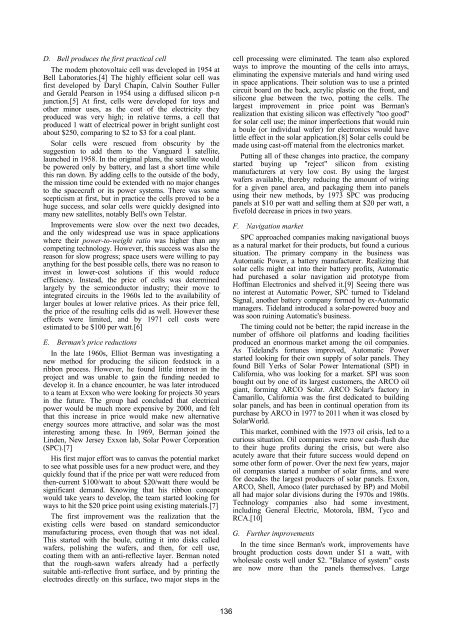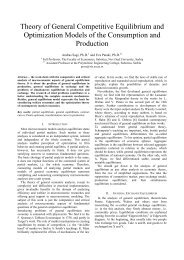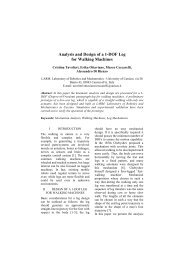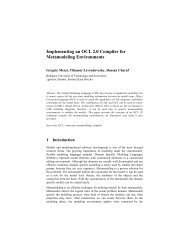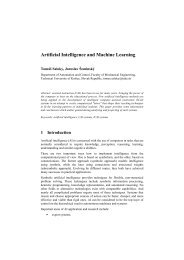D. Bell produces the first practical cellThe modern photovoltaic cell was developed in 1954 atBell Laboratories.[4] The highly efficient solar cell wasfirst developed by Daryl Chapin, Calvin Souther Fullerand Gerald Pearson in 1954 using a diffused silicon p-njunction.[5] At first, cells were developed for toys andother minor uses, as the cost of the electricity theyproduced was very high; in relative terms, a cell thatproduced 1 watt of electrical power in bright sunlight costabout $250, comparing to $2 to $3 for a coal plant.Solar cells were rescued from obscurity by thesuggestion to add them to the Vanguard I satellite,launched in 1958. In the original plans, the satellite wouldbe powered only by battery, and last a short time whilethis ran down. By adding cells to the outside of the body,the mission time could be extended with no major changesto the spacecraft or its power systems. There was somescepticism at first, but in practice the cells proved to be ahuge success, and solar cells were quickly designed intomany new satellites, notably Bell's own Telstar.Improvements were slow over the next two decades,and the only widespread use was in space applicationswhere their power-to-weight ratio was higher than anycompeting technology. However, this success was also thereason for slow progress; space users were willing to payanything for the best possible cells, there was no reason toinvest in lower-cost solutions if this would reduceefficiency. Instead, the price of cells was determinedlargely by the semiconductor industry; their move tointegrated circuits in the 1960s led to the availability oflarger boules at lower relative prices. As their price fell,the price of the resulting cells did as well. However theseeffects were limited, and by 1971 cell costs wereestimated to be $100 per watt.[6]E. Berman's price reductionsIn the late 1960s, Elliot Berman was investigating anew method for producing the silicon feedstock in aribbon process. However, he found little interest in theproject and was unable to gain the funding needed todevelop it. In a chance encounter, he was later introducedto a team at Exxon who were looking for projects 30 yearsin the future. The group had concluded that electricalpower would be much more expensive by 2000, and feltthat this increase in price would make new alternativeenergy sources more attractive, and solar was the mostinteresting among these. In 1969, Berman joined theLinden, New Jersey Exxon lab, Solar Power Corporation(SPC).[7]His first major effort was to canvas the potential marketto see what possible uses for a new product were, and theyquickly found that if the price per watt were reduced fromthen-current $100/watt to about $20/watt there would besignificant demand. Knowing that his ribbon conceptwould take years to develop, the team started looking forways to hit the $20 price point using existing materials.[7]The first improvement was the realization that theexisting cells were based on standard semiconductormanufacturing process, even though that was not ideal.This started with the boule, cutting it into disks calledwafers, polishing the wafers, and then, for cell use,coating them with an anti-reflective layer. Berman notedthat the rough-sawn wafers already had a perfectlysuitable anti-reflective front surface, and by printing theelectrodes directly on this surface, two major steps in thecell processing were eliminated. The team also exploredways to improve the mounting of the cells into arrays,eliminating the expensive materials and hand wiring usedin space applications. Their solution was to use a printedcircuit board on the back, acrylic plastic on the front, andsilicone glue between the two, potting the cells. Thelargest improvement in price point was Berman'srealization that existing silicon was effectively "too good"for solar cell use; the minor imperfections that would ruina boule (or individual wafer) for electronics would havelittle effect in the solar application.[8] Solar cells could bemade using cast-off material from the electronics market.Putting all of these changes into practice, the companystarted buying up "reject" silicon from existingmanufacturers at very low cost. By using the largestwafers available, thereby reducing the amount of wiringfor a given panel area, and packaging them into panelsusing their new methods, by 1973 SPC was producingpanels at $10 per watt and selling them at $20 per watt, afivefold decrease in prices in two years.F. Navigation marketSPC approached companies making navigational buoysas a natural market for their products, but found a curioussituation. The primary company in the business wasAutomatic Power, a battery manufacturer. Realizing thatsolar cells might eat into their battery profits, Automatichad purchased a solar navigation aid prototype fromHoffman Electronics and shelved it.[9] Seeing there wasno interest at Automatic Power, SPC turned to TidelandSignal, another battery company formed by ex-Automaticmanagers. Tideland introduced a solar-powered buoy andwas soon ruining Automatic's business.The timing could not be better; the rapid increase in thenumber of offshore oil platforms and loading facilitiesproduced an enormous market among the oil companies.As Tideland's fortunes improved, Automatic Powerstarted looking for their own supply of solar panels. Theyfound Bill Yerks of Solar Power International (SPI) inCalifornia, who was looking for a market. SPI was soonbought out by one of its largest customers, the ARCO oilgiant, forming ARCO Solar. ARCO Solar's factory inCamarillo, California was the first dedicated to buildingsolar panels, and has been in continual operation from itspurchase by ARCO in 1977 to 2011 when it was closed bySolarWorld.This market, combined with the 1973 oil crisis, led to acurious situation. Oil companies were now cash-flush dueto their huge profits during the crisis, but were alsoacutely aware that their future success would depend onsome other form of power. Over the next few years, majoroil companies started a number of solar firms, and werefor decades the largest producers of solar panels. Exxon,ARCO, Shell, Amoco (later purchased by BP) and Mobilall had major solar divisions during the 1970s and 1980s.Technology companies also had some investment,including General Electric, Motorola, IBM, Tyco andRCA.[10]G. Further improvementsIn the time since Berman's work, improvements havebrought production costs down under $1 a watt, withwholesale costs well under $2. "Balance of system" costsare now more than the panels themselves. Large136
commercial arrays can be built at below $3.40 a watt,[11][12] fully commissioned.As the semiconductor industry moved to ever-largerboules, older equipment became available at fire-saleprices. Cells have grown in size as older equipmentbecame available on the surplus market; ARCO Solar'soriginal panels used cells with 2 to 4 inch (51 to 100 mm)diameter. Panels in the 1990s and early 2000s generallyused 5 inch (125 mm) wafers, and since 2008 almost allnew panels use 6 inch (150 mm) cells. Another majorchange was the move to polycrystalline silicon. Thismaterial has less efficiency, but is less expensive toproduce in bulk. The widespread introduction of flatscreen televisions in the late 1990s and early 2000s led tothe wide availability of large sheets of high-quality glass,used on the front of the panels.H. Current eventsOther technologies have tried to enter the market. FirstSolar was briefly the largest panel manufacturer in 2009,in terms of yearly power produced, using a thin-film cellsandwiched between two layers of glass. Since thenSilicon panels reasserted their dominant position both interms of lower prices and the rapid rise of Chinesemanufacturing, resulting in the top producers beingChinese. By late 2011, efficient production in China,coupled with a drop in European demand due to budgetaryturmoil had dropped prices for crystalline solar-basedmodules further, to about $1.09[12] per watt in October2011, down sharply from the price per watt in 2010.I. Applications, photovoltaic systemSolar cells are often electrically connected andencapsulated as a module. Photovoltaic modules oftenhave a sheet of glass on the front (sun up) side, allowinglight to pass while protecting the semiconductor wafersfrom abrasion and impact due to wind-driven debris, rain,hail, etc. Solar cells are also usually connected in series inmodules, creating an additive voltage. Connecting cells inparallel will yield a higher current; however, verysignificant problems exist with parallel connections. Forexample, shadow effects can shut down the weaker (lessilluminated) parallel string (a number of series connectedcells) causing substantial power loss and even damagingexcessive reverse bias applied to the shadowed cells bytheir illuminated partners. As far as possible, strings ofseries cells should be handled independently and notconnected in parallel, save using special parallelingcircuits. Although modules can be interconnected in seriesand/or parallel to create an array with the desired peakDC voltage and loading current capacity, usingindependent MPPTs (maximum power point trackers)provides a better solution. In the absence of parallelingcircuits, shunt diodes can be used to reduce the power lossdue to shadowing in arrays with series/parallel connectedcells.To make practical use of the solar-generated energy, theelectricity is most often fed into the electricity grid usinginverters (grid-connected photovoltaic systems); in standalonesystems, batteries are used to store the energy that isnot needed immediately. Solar panels can be used topower or recharge portable devices.II.THEORY OF SOLAR CELLSThe solar cell works in three steps:1.Photons in sunlight hit the solar panel and areabsorbed by semiconducting materials, such as silicon.2.Electrons (negatively charged) are knocked loosefrom their atoms, causing an electric potential difference.Current starts flowing through the material to cancel thepotential and this electricity is captured. Due to the specialcomposition of solar cells, the electrons are only allowedto move in a single direction.3.An array of solar cells converts solar energy into ausable amount of direct current (DC) electricity.III.SOLAR CELL EFFICIENCYSolar panels on the International Space Station absorblight from both sides. These Bifacial cells are moreefficient and operate at lower temperature than singlesided equivalents.The efficiency of a solar cell may be broken down intoreflectance efficiency, thermodynamic efficiency, chargecarrier separation efficiency and conductive efficiency.The overall efficiency is the product of each of theseindividual efficiencies.Due to the difficulty in measuring these parametersdirectly, other parameters are measured instead:thermodynamic efficiency, quantum efficiency, integratedquantum efficiency, V OCratio, and fill factor. Reflectancelosses are a portion of the quantum efficiency under"external quantum efficiency". Recombination lossesmake up a portion of the quantum efficiency, V OCratio,and fill factor. Resistive losses are predominantlycategorized under fill factor, but also make up minorportions of the quantum efficiency, V OCratio.The fill factor is defined as the ratio of the actualmaximum obtainable power, to the product of the opencircuit voltage and short circuit current. This is a keyparameter in evaluating the performance of solar cells.Typical commercial solar cells have a fill factor > 0.70.Grade B cells have a fill factor usually between 0.4 to 0.7.The fill factor is, besides efficiency, one of the mostsignificant parameters for the energy yield of aphotovoltaic cell.[13] Cells with a high fill factor have alow equivalent series resistance and a high equivalentshunt resistance, so less of the current produced by light isdissipated in internal losses.Single p-n junction crystalline silicon devices are nowapproaching the theoretical limiting efficiency of 37.7%,noted as the Shockley–Queisser limit in 1961. Howevermultiple layer solar cells have a theoretical limit of 86%.In October 2010, triple junction metamorphic cellreached a record high of 42.3%.[14] This technology iscurrently being utilized in the Mars Exploration Rovermissions, which have run far past their 90 day design life.The Dutch Radboud University Nijmegen set the recordfor thin film solar cell efficiency using a single junctionGaAs to 25.8% in August 2008 using only 4 µm thickGaAs layer which can be transferred from a wafer base toglass or plastic film.[15]137
- Page 1 and 2:
4 4 th IEEE International Symposium
- Page 3 and 4:
EXPRES 20124 th International Sympo
- Page 5 and 6:
Application of Thermopile Technolog
- Page 7 and 8:
Design of a Solar Hybrid System....
- Page 9 and 10:
___________________________________
- Page 11 and 12:
environmental protection and global
- Page 13 and 14:
But can we use the human body sweat
- Page 15 and 16:
IX. REFERENCES[1] Todorovic B. Cvje
- Page 17 and 18:
QQ⎛ Λt⎞=⎜⎟⎝ Λ ⎠Nt Nwh
- Page 19 and 20:
Analysis of the Energy-Optimum of H
- Page 21 and 22:
V. OBJECTIVE FUNCTIONThe objective
- Page 23 and 24:
The Set-Up Geometry of Sun Collecto
- Page 25 and 26:
continuous east-west sun collector
- Page 27 and 28:
continuously measure the thermal ch
- Page 29 and 30:
CEvaluation of measurement resultsA
- Page 31 and 32:
Application of Thermopile Technolog
- Page 33 and 34:
Temperature of the components [C]90
- Page 35 and 36:
nighttime, to weather or to the cha
- Page 37 and 38:
η uη u0.50.40.30.20.1T 1 - 400K0.
- Page 39 and 40:
Figure 10. . SPS Concept illustrati
- Page 41 and 42:
[16] Zoya B. Popović: Wireless Pow
- Page 43 and 44:
25.0020.0015.0010.005.000.00Figure
- Page 45 and 46:
· ℃ 0.0738 · 1.209 0.0892
- Page 47 and 48:
use may be advantageous not only in
- Page 49 and 50:
To find the reasons for this disagr
- Page 51 and 52:
Toward Future: Positive Net-Energy
- Page 53 and 54:
EnergyPlus environment, we used mod
- Page 55 and 56:
To keep future energy consumption d
- Page 57 and 58:
A New Calculation Method to Analyse
- Page 59 and 60:
On Fig. 3. can be seen the areas th
- Page 61 and 62:
Present and Future of Geothermal En
- Page 63 and 64:
TABLE II.THE TEMPERATURE DATA AND C
- Page 65 and 66:
Error in Water Meter Measuring at W
- Page 67 and 68:
III.RESULTS OF MEASURMENTSEach meas
- Page 69 and 70:
TABLE I.THE AVERAGE VALUE OF THERMA
- Page 71 and 72:
If the walls of the DHEs are made o
- Page 73 and 74:
Environmental External Costs Associ
- Page 75 and 76:
iodiesel production facility with a
- Page 77 and 78:
Contribution of unit processesto ex
- Page 79 and 80:
Heat Pump News in HungaryBéla Ád
- Page 81 and 82:
Thermal Comfort Measurements In Lar
- Page 83 and 84:
IV.DISCUSSIONThe sample frequencies
- Page 85 and 86:
For a Clear View of Traditional and
- Page 87 and 88: esults in geographically distribute
- Page 89 and 90: Design of a Solar Hybrid SystemMari
- Page 91 and 92: Maintaining the set point temperatu
- Page 93 and 94: Decision system theory model of ope
- Page 95 and 96: parameter of pump in the function o
- Page 97 and 98: Importance and Value of Predictive
- Page 99 and 100: D. Overview of existing boiler oper
- Page 101 and 102: HEAVY FUEL OIL FIRED, STEAMNATURAL
- Page 103 and 104: MATHEMATICAL MODEL AND NUMERICAL SI
- Page 105 and 106: C. Energy balance equationMathemati
- Page 107 and 108: Discretization energy balance equat
- Page 109 and 110: T ulf=32 º C, A - m =0.00162 kg/s,
- Page 111 and 112: Comparison of Heat Pump and MicroCH
- Page 113 and 114: the microCHP development. The energ
- Page 115 and 116: control and stabilizer must be deve
- Page 117 and 118: In Figure 1, in relation to the ord
- Page 119 and 120: NPCC BHXOBYNI x1I x2I x3I x4LO YKYO
- Page 121 and 122: exchange, as in reality, economies
- Page 123 and 124: esponsibilities for consequences, o
- Page 125 and 126: Coca-Cola Enterprise Inc had approx
- Page 127 and 128: Flow Pattern Map for In Tube Evapor
- Page 129 and 130: circumference with a liquid film. T
- Page 131 and 132: Tube diameter: d 6 mm W Heat flux
- Page 133 and 134: Realization of Concurrent Programmi
- Page 135 and 136: applications the development, optim
- Page 137: Renewable energy sources in automob
- Page 141 and 142: of multiple thin films produced usi
- Page 143: EXPRES 20124 th International Sympo


